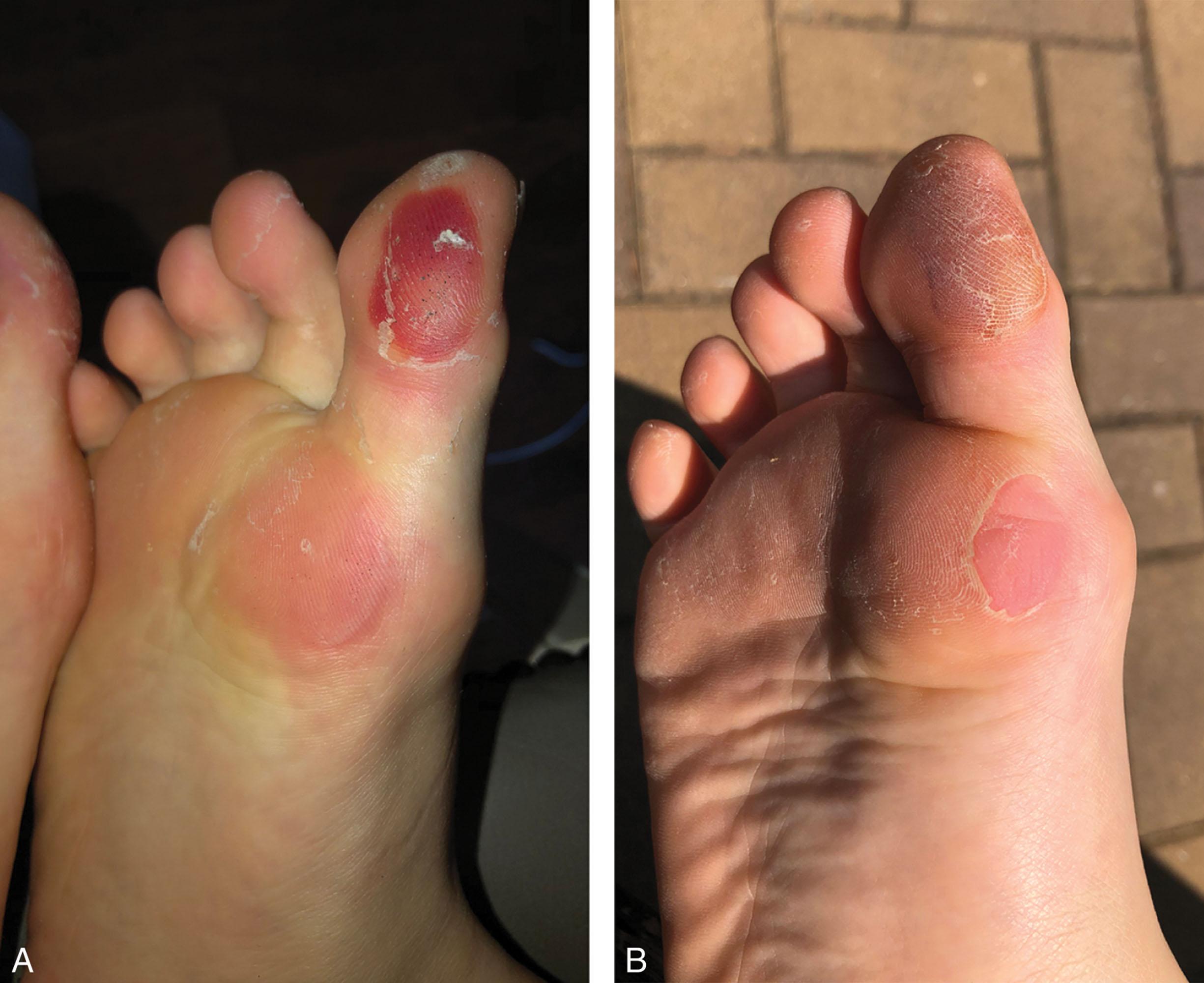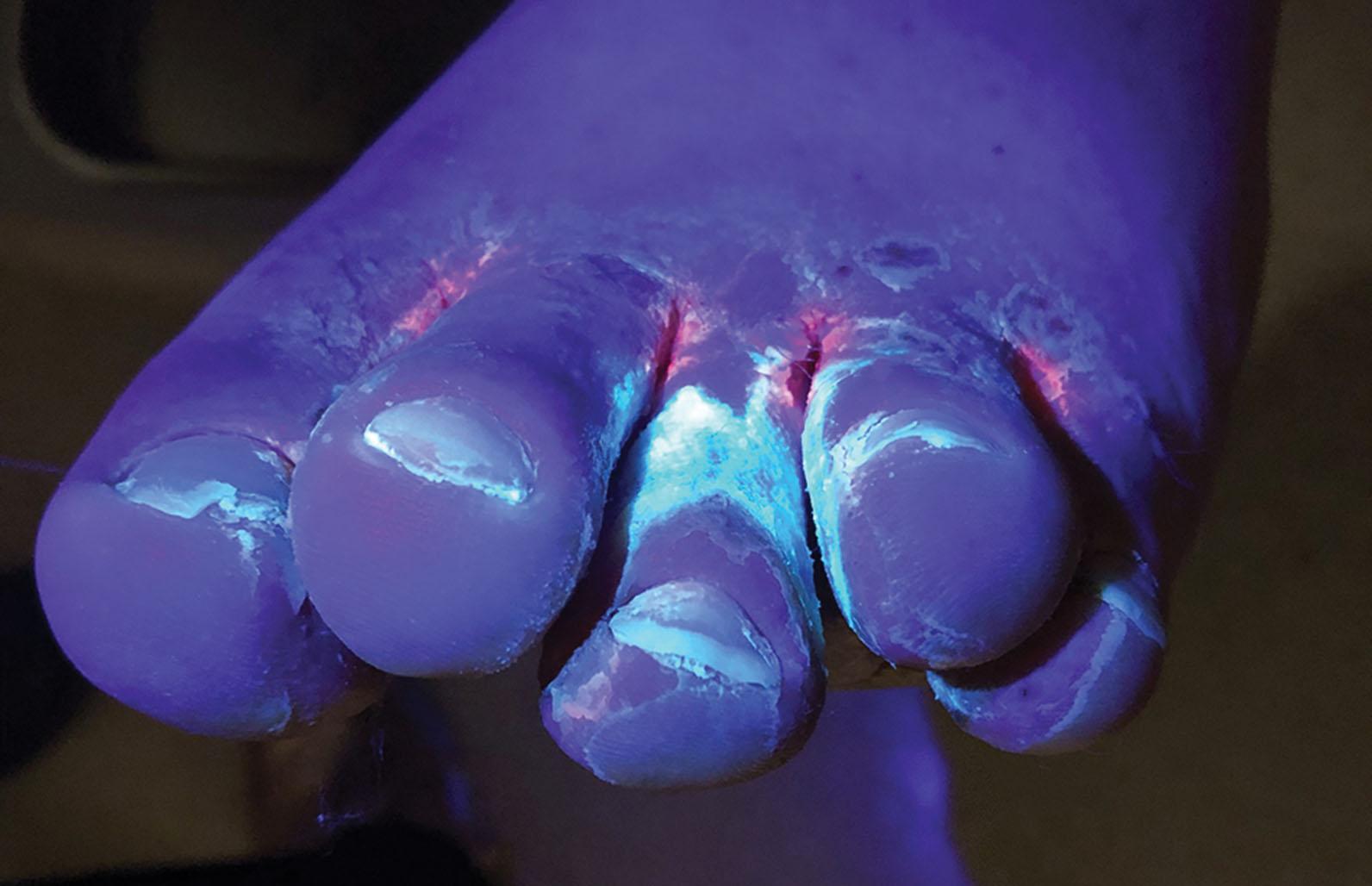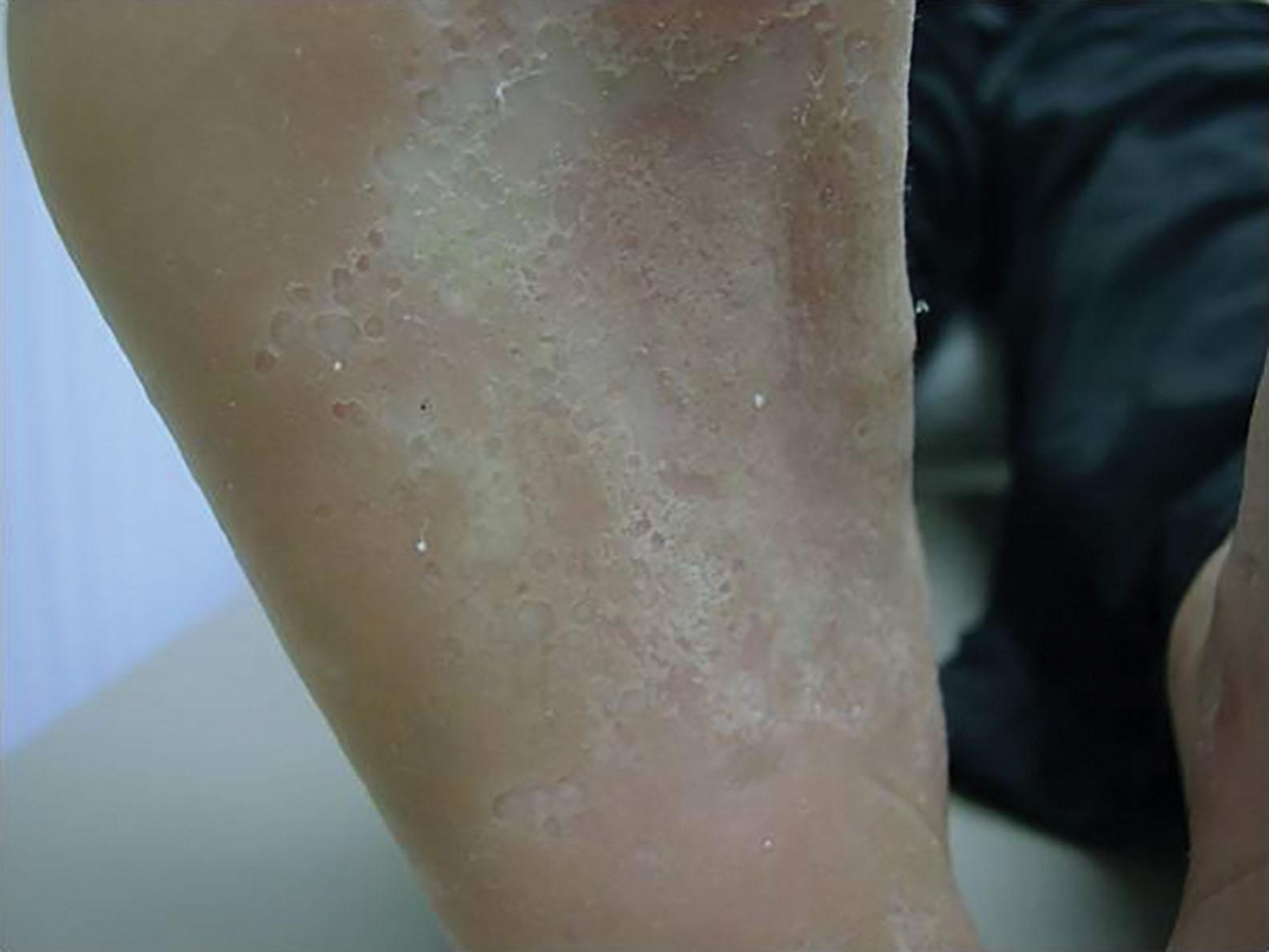Physical Address
304 North Cardinal St.
Dorchester Center, MA 02124
A patient presenting with a skin condition can prove to be a challenge to diagnose and manage. When faced with a patient with a skin condition in the office, the practitioner should have a systematic approach to arrive at a baseline differential diagnosis: observe and ask. After clinically visualizing the lesion, it may be helpful to perform a skin biopsy in order to refine the diagnosis or, in some cases, act as a therapeutic tool to excise the lesion.
Upon entering into the treatment room, the practitioner should notice color, shape, and size in addition to laterality of the lesions on the lower extremity. Primary and secondary lesions (e.g., macule, pustule, vesicle) ( Table 16-1 ) should be used to describe the rash appropriately both in the chart and in correspondence to other physicians. When looking at the shape of the lesions, it is helpful to determine if they were self-induced by the patient (excoriation by a fingernail) or naturally caused (scaly skin). One should document if the lesions are plantar foot, dorsal foot, or ascending proximally on the lower leg. Nail involvement should be noted. Finally, the fingernails and dorsum and palmar aspects of the hands should be examined as many skin dermatoses mirror pedal involvement.
| Primary skin lesions |
|
| Secondary skin lesions |
|
Questions that will help form differential diagnoses should be asked while completing the physical exam of the skin. Beyond asking the history of present illness, past medical history, and family history, the physician should consider asking if there is a personal or family history of allergic rhinitis, sensitive skin, asthma, or skin cancer. The patient should be asked if he has ever seen a specialist before and if there are any skin lesions or “rashes” anywhere else on the body that may or may not be similar to what is seen on the lower extremity. Unfortunately, most patients do not correlate what is happening on the rest of the body to what is manifesting on the plantar aspect of the feet. It is the physician’s responsibility to ask the questions in order to make that connection.
It is helpful to ask if the skin has ever been biopsied (e.g., “did you have a piece of skin removed and then have stitches?”). A skin scraping for Potassium Hydroxide (KOH) that was completed by another physician does not count as a proper biopsy on which to base the diagnosis; a biopsy of inflammatory skin disorders should include the dermis from a pathology perspective. Other questions to consider asking patients are the color of socks they wear (azo dyes in blue socks can be a potential allergen), daily recreational activities, and any associated daily hazards. Also, one should ask about both over-the-counter and homeopathic or natural treatment options they have tried. In order to plan for a possible in-office biopsy that visit, it is important to ask what the natural progression of the lesions has been and where the newest crop of lesions are located.
After the basic observation and questioning have occurred, it’s important to delve more deeply into the chief complaint and examine the skin fully.
When the skin barrier is compromised from the weather, insects, or trauma, the skin will react in various ways.
Sunburn is an inflammatory reaction to the cellular damage from ultraviolet B radiation. It presents as pain and tenderness of the skin with an erythematous discoloration progressing to desquamation. More severe cases will be accompanied by fatigue, headache, and chills. Treatment consists of local support consisting of topical corticosteroids, cooling baths, emollient creams, oral nonsteroidal antiinflammatory medications, and hydration.
The depth of a tan whether from a tanning salon bed or environmental exposure is a direct correlation of the amount of ultraviolet radiation absorbed by the skin. As radiation damages the cells, melanocytes are activated and produce more melanosomes. The melanosomes, or sacs containing pigment, are then transferred to the keratinocytes. Long-term sequelae of tanning include photodamage (wrinkles, pigmentation) and a decreased immune response of the processes suppressing conditions like herpes simplex virus and non-melanoma skin cancer.
Burns from heat may be caused by dry or wet heat as well as chemicals. They are classified upon the depth of damage involved within the epidermis and dermis. Patients with diabetes are prone to scalding burns due to sensory neuropathy. Localized bullae following the injury may be treated with local wound care, but more extensive and deeper burns require admission to a facility for intravenous fluid replacement, debridement of devitalized tissue, analgesics, antibiotics, and possible skin grafting or amputation depending on the extent of injury.
Pernio is a non-freezing injury that occurs in response to repeated cold exposure with humid conditions and manifests itself as erythematous to violaceous papules, nodules, or plaques that may burn, be pruritic, or become vesicles. This typically happens on toes and fingers. The lesions may occur 24 hours after exposure and last from 1 to 3 weeks. Warming the affected part and wearing appropriate clothing during future cold exposure is helpful in treatment and prevention.
Frostnip is a milder form of cold injury compared to pernio. It generally occurs on the most distal aspects: toes, fingers, nose, and ears. It represents a superficial injury to the skin and manifests itself as blanching of the skin and numbness. It is reversible upon re-warming of the part and preventing further cold exposure.
Due to the similarity of the injury to burns, frostbite is classified as first, second, third, and fourth degree injuries; however, most physicians classify it either as superficial (includes first and second degree) or deep (third and fourth degree). Upon initial presentation, it is difficult to tell which degree of frostbite is present. Only after re-warming can the clinician tell how deeply the layers of the skin and subcutaneous tissue have been affected. The skin and subcutaneous tissue are affected in superficial frostbite, which may manifest as non-blanching anesthetic white waxy skin that will become painful upon thawing as well as edematous with serous vesicles and bullae. Deep frostbite goes beyond the skin and subcutaneous tissues into the muscles, neurovascular structures, and bone. The frozen part may look wooden and have a lack of sensation that may look ashen upon re-warming. Hemorrhagic bullae may form eventually.
After removing the patient from the environment, rapid re-warming in a bath of 39°C to 42°C is indicated. Tetanus status should be verified as these injuries can be tetanus prone.
Having an insect sting or bite is common on the lower extremity due to exposure of skin secondary to lack of clothing coverage (shorts, skirts, etc.). First, it is important to distinguish between bites and stings. An insect bite from the mouth parts is to feed from the host whereas a sting is in self-defense. Most of the time, an insect (particularly a bee) can sting only once but can bite multiple times. In certain cases, an insect such as the wasp can both sting and bite at the same time.
Hymenoptera include bees, wasps, and ants whose stings can cause both local and systemic (anaphylaxis) reactions. Local reactions may appear as an urticarial wheal with a central puncture mark that may in time become excoriated by the patient. A mild reaction may be treated with ice and an oral antihistamine whereas a more severe local reaction would require systemic corticosteroids. Anaphylaxis should be treated with a subcutaneous or intramuscular injection of epinephrine (0.01 mg/kg) and the emergency response system should be activated. If not treated, anaphylaxis may lead to death. In addition, a high number of stings (500–1000) may also lead to death.
Scabies is from the human scabies mite Sarcoptes scabiei var hominis . The mode of transmission is usually from an infected person in close contact with the patient, but they can also live several days on fomites such as bed linen. A hallmark of the infestation is an intractable itch that is worse at night. The pathognomonic lesion is a burrow that may present as a small grayish line at the interdigital webs of the hands and feet, anterior wrists, axillary folds, and ankles. In young children, an extensive eczematous eruption on the trunk or chest may appear. Infants may have papules and vesicles on the palms and soles. The intense pruritus associated with these lesions convert the burrows into excoriations and possibly secondarily infected lesions.
A skin scraping of the infested site may confirm the presence of the mite as well as its larvae, ova, and fecal matter. As soon as a diagnosis is made, the patient, all of his or her contacts, bed linens, and clothing should be treated or laundered. Permethrin 5% is the topical treatment of choice and is applied from head to toe once weekly for a minimum of 2 consecutive weeks.
Both human and animal-caused bites can be a source of trauma to the lower extremity. Human bites may come from aggressive rough-housing and can present as superficial semi-circular contusions, scratches, or lacerations. They more commonly occur on the upper extremity but can occur on the lower extremity. Infection is the most common complication and local wound care should be initiated as soon as possible.
A patient wearing new, ill-fitting shoes may cause vesicles or bullae to form, especially in the presence of hyperhidrosis. These lesions may or may not be drained, but local wound care and protection of the lesions should be considered ( Fig. 16-1 ).

Talon noir, or calcaneal petechiae, is a non-painful, self-limiting lesion that can arise after sports in young adults. It is a result of continuous lateral shearing force in the shoe. It has been classically described following playing basketball but can occur in any sport that has frequent stops and starts. The small macules are located over the posterior to posterolateral aspect of the calcaneus and will resolve on their own.
Genodermatoses or inherited skin conditions contain a subset of hereditary palmoplantar keratodermas (PPK). These genetic skin disorders characteristically involve hyperkeratosis of the palms and soles. The patterns of hyperkeratosis are further divided into diffuse and focal groups.
Vörner-Unna-Thost type: Also known as epidermolytic palmoplantar hyperkeratosis or Unna-Thost type, this PPK is the most common of these conditions a practitioner will encounter at a rate of 1 : 100,000. It is autosomally dominantly inherited with mutations seen in keratins 9 and 1. It clinically presents as diffuse areas of yellow hyperkeratotic plaques on the palms and soles surrounded by an erythematous border. Nail changes and fungal superinfections may also be seen.
Vohwinkel type: This PPK may also be known as keratosis palmoplantaris mutilans and mutilating keratoderma with deafness. It is a dominant negative mutation for the genes that code for connexin 26. This ultimately can affect both hearing and the skin. The plantar and palmar skin appear as diffuse honeycombed yellow hyperkeratosis with hyperhidrosis. Over time, constrictions can occur at the distal joints, which may lead to pseudoainhum and ultimately, auto-amputation.
Pachyonychia congenita: There are two types: type I or Jadassohn-Lewandowsky type and type II (Jackson-Lawler type). It is also inherited in an autosomal dominant fashion with mutations in keratin 6a and 16 in type I; and 6b and 17 in type II. In this type of PPK, the main skin appendage affected is the nails. Nails, shortly after birth, become hyperkeratotic and dystrophic. Focal plantar hyperkeratoses over pressure points may also develop.
Tuberous sclerosis: Although not a PPK, this disease is inherited by autosomal dominance. Tuberous sclerosis is often associated with multiple periungual fibromas around the nail unit, which makes nail debridement challenging. These numerous fibromas, or Koenen’s tumors, may distort the nail plate. Also associated with tuberous sclerosis are areas of hypopigmentation, which when illuminated with a Wood’s lamp appear as ash tree leaves.
There is a lack of randomized, controlled studies due to the small size of this patient population. First-line therapy generally consists of a topical keratolytic to aid in desquamation. Choices include urea (10%–40%), salicylic acid (6%), and lactic acid (12%). The physician should also consider the prophylactic use of topical antifungal therapies that can occur in patients with concurrent hyperhidrosis. Further therapies beyond topical medications are skin and nail debridement by a physician, soaking and use of pumice stone by the patient, laser ablation, and lastly surgical debridement followed by a skin graft. The systemic retinoid acitretin is used long term to decrease many side effects, but as always, benefit should outweigh risk as the side effects of retinoids should be considered (premature growth plate closure, elevated serum fats, and osteoporosis). Genetic counseling should be considered in this patient population.
Bacterial infections can generally be divided into staph-caused and strep-caused. Community-acquired MRSA (methicillin-resistant Staphylococcus aureus ) is widely prevalent and should now be ruled out as a pathogen for simple lesions such as carbuncles and paronychias of the great toe. Corynebacterium and Pseudomonas can also be pathogens. The type of bacteria and the level of skin invasion will present with characteristic skin conditions. If the infection is severe and not treated, complications such as sepsis, kidney failure, and heart disease may occur.
Staphylococci or group A Streptococcus pyogenes may penetrate a skin abrasion and cause blistering. If it is staph induced, the blister may be a flaccid blister with lakes of purulence visible. If caused by strep, the blister is fragile and upon breaking will form a honey-colored crust-like appearance. It is extremely contagious. For a localized skin reaction of either the bullous or non-bullous type, topical mupirocin or retapamulin may be applied. For a more extensive presentation, oral dicloxacillin or cefazolin may be prescribed for 7 to 10 days.
This may also be caused by staph or strep and penetrates through a wound or a macerated area. First presentation may be a localized area of erythema, calor, edema, dolor that may progress to lymphangitis or erythematous streaking proximally, lymphadenopathy, and constitutional signs and symptoms (fever, malaise, and chills). Treatment is generally application of intravenous antibiotics such as a combination of cefazolin/clindamycin or linezolid alone in addition to an incision and drainage of a distal abscess if present.
Inflammation and colonization of the hair follicles may present with tender, irritated areas. It may start out as a pustule or erythematous papule around the hair unit and may progress to the staph-induced furuncle (boil) and ultimately a network of furuncles or a carbuncle. The treatment of carbuncles generally involves incision and drainage as well as systemic antibiotic therapy. Folliculitis may also be caused by a dermatophyte and Pseudomonas and systemic therapies should be targeted for those organisms.
A superficial infection of the intertriginous areas of the skin, such as the interdigital web spaces by Corynebacterium minutissimum , produces erythrasma. Erythrasma may appear as a macerated interdigital infection with some scale and malodor. Upon illumination under a Wood’s lamp, Corynebacterium will fluoresce coral red, or if caused by Pseudomonas will fluoresce green ( Fig. 16-2 ). Pitted keratolysis is a superficial infection also caused mainly by Corynebacterium on the plantar aspect of the foot. It is characterized by tiny craters and maceration ( Fig. 16-3 ). It will not generally fluoresce under a Wood’s lamp. Classically, this is treated with a topical antibiotic such as clindamycin or erythromycin and a drying agent like aluminum chloride solution.


Become a Clinical Tree membership for Full access and enjoy Unlimited articles
If you are a member. Log in here